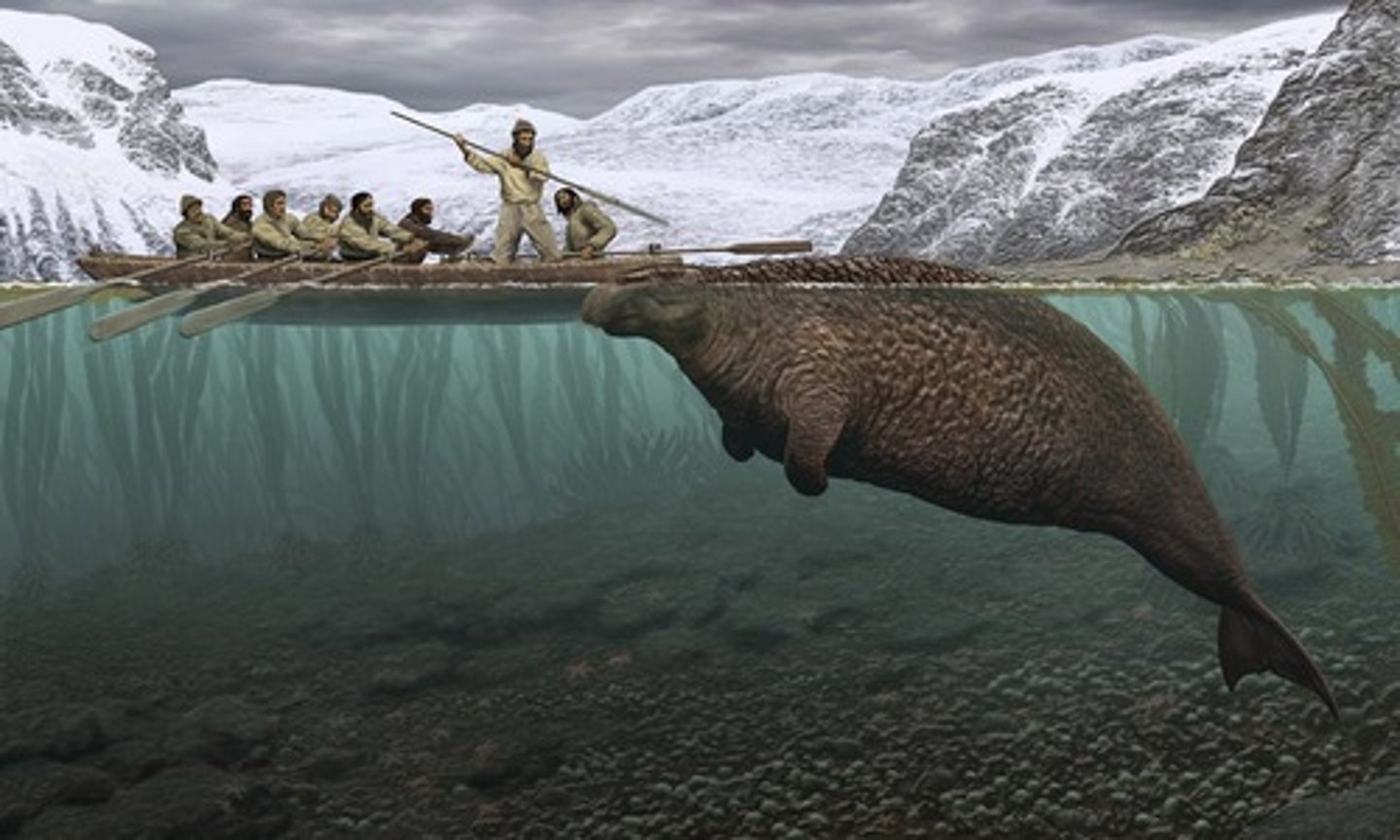Endangered Species
1/24
There's no tags or description
Looks like no tags are added yet.
Name | Mastery | Learn | Test | Matching | Spaced |
|---|
No study sessions yet.
25 Terms
Species Extinction
Most scientists agree that currently experiencing the highest rate of species extinction since dinosaurs died out 65 million years ago. Some scientists think that only half of the world's existing species will survive to the year 2100. In the U.S. alone, about 60 species of mammals and 40 species of freshwater fish have died out over the past 100 years
Extinct Species Examples
Carolina Parakeet, Quagga, Stellar Sea Cow

Causes of Species Extinction
Humans are major cause current wave of extinctions.
- Habitat destruction and modification are the major threats in the US
- Competition from exotic species for food and habitat is a growing threat
- Overhunting and overfishing also contribute, although on a much smaller scale
- Climate change and pollution are also increasingly important contributors
Endangered Species Act (ESA)
This Act bans hunting or killing endangered species and protects against significant habitat loss. This is controversial because does not have obvious direct benefits to humans but can have significant effects, including:
- Restricting land development
- Reducing amount of water that farmers and cities can divert from waterways
- Constraining federal government's ability to build dams and highways and develop petroleum or lumber sources
Passing the ESA
Congress had no idea how controversial ESA would be when enacted in 1973. They thought it to be a "warm and fuzzy" law that would protect "charismatic megafauna" (bald eagles and grizzly bears) from hunters and poachers.
Should ESA balance benefits of preserving a species against costs?
Cost plays only a marginal role in implementation of the ESA's restrictions, which do not provide for explicit balancing of costs and benefits.
Why Protect Species?
- ESA says: endangered species "are of esthetic, ecological, educational, historical, recreational, and scientific value to the Nation and its people"
- Economic values: food, ecotourism, genetic diversity, etc.
- Religious or moral reasons
- Ecological Values: protecting the larger ecosystem, habitat protection (Loss of a single species can sometimes have dramatic impacts on an ecosystem, keystone species)
Responsibility for Administering ESA
There are two:
- Fish and Wildlife Service (FWS): Terrestrial and avian species and freshwater fish
- National Marine Fisheries Service (NMFS): Marine species
Listing Species Under the ESA
ESA protects only species that are listed by FWS as endangered or threatened. In general, the ESA provides the same level of protection for threatened and endangered (T&E) species.
Endangered Species Definition
"In danger of extinction throughout all or significant portion of its range"
Extirpated Species
A species that no longer exists in a specific area
Threatened Species
"likely to become an endangered species in the foreseeable future"
How Does a species get on the List?
4 allows FWS to list a species on its own, or an individual or organization can request a species be listed
- In 1973, there were 392 species listed
- Now, over 2,400 listed species (1,660 in US)
- Hawaii (503) has most, followed by CA (301) , FL (135), AL (127) and TN (94)
How long it take to list a species
FWS has 90 days from receiving listing petition to determine if sufficient reason to order full review. The final determination must occur within one year thereafter.
Requirements for Making Listing Decisions
- Use "best scientific and commercial data available". FWS adopted peer review policy that seeks input from expert scientists (increases deference by courts to FWS determinations)
- Not allowed to consider the potential economic consequences ( although there is tremendous pressure to do so)
Pressures from Economy for Listing Species
FWS often faces great pressure not to list a species and can avoid or delay listing by:
- Concluding it needs additional information before making determination
- Declaring a listing "warranted" but "precluded" by higher listings priorities
- Finding that other efforts to preserve a species provide adequate protection
Limits on Federal Agency Actions
Under *7 federal agencies must:
- Consult with FWS before doing anything that might affect an endangered or threatened species
- Ensure that the action is not likely to jeopardize the species' continued existence or destroy or adversely modify the species' critical habitat
Section 7 EPA
Federal agencies must
- consult with FWS before taking action impacting and endangered or threatened species
- Ensure that the action is not likely to jeopardize the species continued existence; or destroy or adversely modify the species critical habitat
Section 9 EPA
Non one can "take" an endangered species of fish or wildlife
How is "take" defined in section 9?
actions that "harass, harm, pursue, hunt, shoot, wound, kill, trap, capture, or collect" an endangered species
Criticisms of Section 9
Property rights advocates are critical of 9 for restricting use of land and water without compensation. These concerns fall into 3 main categories.
3 Categories of section 9 concerns
Inverse Condemnation
A few property owners have bought "constitutional takings" challenges to section 9. An example would ne a water storage district being prohibited from using water source because of an endangered species. They can pass the regulation, but they must provide compensation (This constitutes a taking). A.K.A, they passed the Lucas test.
Also, landowners who have challenged habitat preservation methods as takings have argued that the government authorizes "permanent physical occupations" of their land by protected species, thus interfering with a core property interest.
Lastly, FWS generally is required to prepare recovery plan for endangered or threatened species. No deadline is required for preparation of a plan and priority is given to species "most likely to benefit"
Recovery Plans
These are funded by Congress. There is a preference for charismatic "poster quality" species such as grizzly bears, and bald eagles. Mammals, birds, and fish receive much more funding that reptiles, amphibians, and plants.
Does ESA Work?
As of late 2013, 56 species have been removed from the list